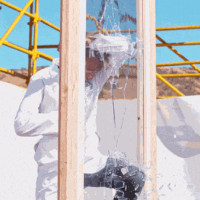When you open the cap of a soft drink bottle or a beer can, you will see air bubbles coming out, which is CO 2 . But why use CO 2 and not any other gas?
CO 2 is a product produced during the combustion or respiration of humans and animals. Under normal conditions, CO2 is an odorless, colorless gas with a slightly acidic taste.

What is the role of CO 2 in carbonated soft drinks? – (Image: Getty Images).
CO2 when dissolved in water forms a weak solution of carbonic acid.
It is carbonic acid combined with flavorings in carbonated soft drinks to create a characteristic sour taste for the product.
When drinking, carbonic acid stimulates the palate, making us feel the characteristic sweet and sour taste of the beverage. Without CO2 , the drink is extremely bland.
In addition, when CO2 bubbles rise to the surface with a special “spray” sound, the product is more attractive, awakening both sight and hearing of the user.

CO 2 is a common gas, soluble in water and safe – (Image: Getty Images).
Science ABC page says that good water solubility is the most important reason when using CO 2 in beverage products. Accordingly, 1.5 liters of CO2 can be dissolved in 1 liter of water at normal pressure gas conditions.
Another reason is safety. In general, CO2 gas is less toxic. Although hydrogen sulfide (H 2 S), ammonia (NH 3 ) or sulfur dioxide (SO 2 ) is much more soluble in water than CO 2 , it cannot be used because of the high risk of toxicity.
When dissolved in water, CO 2 produces very weak carbonic acid (H 2 CO 3 ). This is different from other gases that, when dissolved with water, give off strong acids that are very toxic.
Methane can be used to replace CO2 in carbonated drinks, but methane is flammable. In addition, the environmental impact of using a certain gas on an industrial level can also be considered.

Nowadays, people often produce dry ice from CO 2 used in food preservation – (Photo: Alamy).
In the air, oxygen accounts for 20%, much more than CO 2 , but why not use O 2 in carbonated drinking water?
O2 is the cause of food and drink spoilage. In foods, there are many unstable substances, unsaturated fatty acids, aromatic substances, pigments, vitamins, so they are easily oxidized when exposed to oxygen or air. Food and drinks that are kept for a long time have rancid, stale, loss of aroma or color changes.
Therefore, such “destructive” gas cannot be used in soft drinks.
The cost of CO 2 is also very cheap, which can be used for industrial production. Besides, taking advantage of CO2 emissions to form products with economic value and avoiding concentrated pollution is also a matter worth noting.
In summary, there are many gases that are better than CO 2 in some way, but when combined with all factors: soluble, safe, sustainable, widespread, cheap, CO 2 ranks first.
It should be noted when using soft drinks with too high CO2 concentration because it can lead to calcification of the spine, stomach pain, intestinal ulcers.
CO2 is also heavier than air, so drinking water with high CO2 concentration will make it difficult to breathe, long-term accumulation can cause heart failure.

CO 2 is compressed with high pressure in soft drink cans – (Photo: ykonline).
According to Live Science, freshwater factories use high pressure to force dissolved CO2 into water with a mass/area ratio of about 84.36kg/cm2. After that, people refilled the water tank and closed it, keeping this great pressure.
When the bottle is opened, the external pressure is low, so millions of CO2 molecules immediately fly into the air, causing air bubbles to escape like when boiling water.
When we drink soft drinks, the stomach and intestines do not absorb CO2 . The high temperature environment in the stomach makes CO2 quickly escape through the mouth, taking away some of the heat in the body, making the drinker feel cool and comfortable.
CO2 has the effect of mildly stimulating the stomach wall, enhancing the secretion of gastric juice, helping less for the digestive process.

